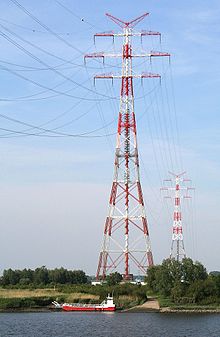Crossing mast

A junction mast (the line crosses an obstacle, hence the name) is an overhead line mast for the realization of an overhead line crossing over a wide river, a strait or a valley.
Crossing masts for crossing valleys do not need to be very high if the topography of the valley allows for suitable cable routing. However, there must be sufficient distance between the conductors to prevent a short circuit between the cables in strong winds or hoarfrost when approaching . For this reason, like overhead line masts, they always have wider traverses for crossing wide rivers and straits . With very large spans, a separate mast is provided for each phase , which enables lower masts. This means that the distance between the phases can be freely selected.
Crossing masts for crossing wide rivers and straits, especially with flat topography, are usually very high constructions in order to ensure the required clearance for ships.

Special crossing masts can often be found at the points where an aerial cableway leads over an overhead line. Here, masts are sometimes used to ensure that the overhead line is scaffolded in the crossing section. In the event of an accident, this measure enables passengers to be rescued from the cable car without having to switch off the line. Such constructions can be found south of Zermatt , at the Patscherkofelbahn in Innsbruck and at the Penkenbahn in Mayrhofen.
A list of known crossings can be found under Overhead Line Crossing .